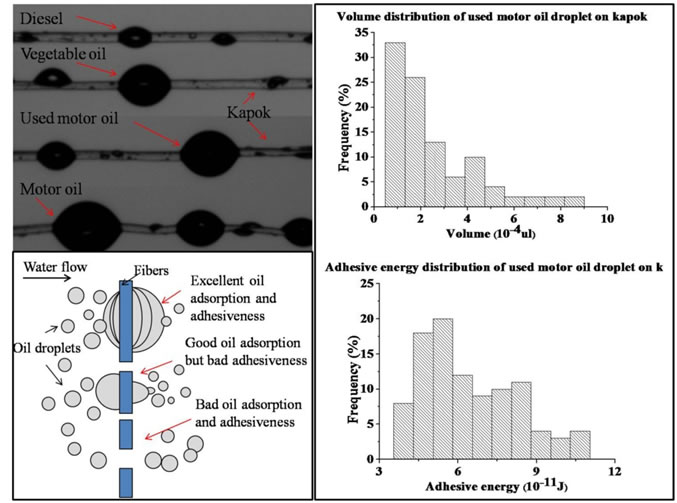
Recently, a Netherlands journal (Journal of hazardous materials) published important achievement on the surface sorption characteristics of hollow kapok fiber. The main researcher includes Guangbiao Xu who is a professor at the college of textile in Donghua University. According to their report, the intrinsic oil adsorption and adhesiveness of kapok fiber was quantitatively evaluated by size and adhesive energy distribution of oil droplets adsorbed on single fiber via drop-on-fiber micro-sorption experiments on the basis of Carroll’s theory of droplet morphology. Relevant theoretical analysis was combined to illustrate the behavior and mechanism of oil capture and retention by kapok fibers in oily water.
Water pollution caused by oil spillages is one of the major environmental problems today. The commonly used synthetic materials for oil sorption are non-renewable resources, which triggers an intensive interest in various natural sorbents. Kapok fiber is a naturally hydrophobic and oleophilic plant fiber which is attracting various academic attentions for its unique hollow lumen structure. Studies on the oil sorption of kapok fibers began with the past decade. Several researchers from Nanyang Technological University, Universiti Teknologi Petronas and Indian Institute of Technology, particularly as well as Prof. Aiqin Wang in Chinese Academy of Sciences and Prof. Guangbiao Xu in Donghua University, have reported oil removalby kapok fibers, and found that oil adsorption and adhesiveness of the fiber are two critical aspects closely related to its oil-to-water separating efficiency. However, the common angle measurement evaluating wettability and adhesiveness of material to liquid by contact angle and roll-off angle is not suitable for oils wetting on surfaces where instant spread of oils happens.
Based on Carroll’s theory of droplet morphology, the authors of this research quantitatively evaluated the intrinsic oil adsorption and adhesiveness of kapok fiber by size and adhesive energy distribution of oil droplets adsorbed on single fiber via drop-on-fiber micro-sorption experiments. It was reported that kapok fibers exhibited very low surface energy of 40.64 mN/m and excellent hydrophobicity with water contact angle high up to 151°. The drop volume of diesel, vegetable oil, used motor oil and motor oil adsorbed by kapok separately ranged among 0.13 - 1.34×10-4 μl, 0.60 - 7.41×10-4 μl, 0.48 - 9.00×10-4 μl and 0.56 - 10.35×10-4 μl, while the average drop adhesive energy of the four oils with kapok fiber were 3.78×10-11 J, 9.40×10-11 J, 6.52×10-11 J and 8.89×10-11 J, respectively. The oil adsorptive and adhesive characteristic of kapok fiber enable it to be used as excellent filter medium for the separation of oily water even in emulsified state (0.1-25 μm) or dispersed state (25-100 μm). This work is believed to be of great interests and meaningfulness considering the unique hollow structure and promising possibilities of kapok fibers applied in oil pollution control.
The research was published with Prof. Guangbiao Xu as the corresponding author and his doctoral student (Ting Dong), as the first author. It was financially supported by “the Fundamental Research Funds for the Central Universities” and “Donghua university doctorial innovation fund for 2014~2015”. The paper can be now found at Journal of Hazardous Materials 296 (2015) 101-111.

